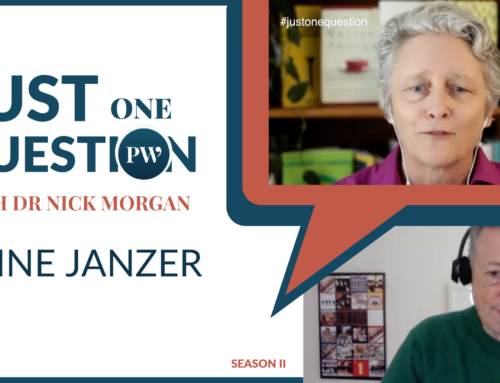Any book published with Nancy Duarte’s name on it is an event in the public speaking world. And so I was thrilled to see that her new book, Illuminate, was due out today, and delighted to have the chance to do a Q and A on it with Nancy and her co-author (and co-worker), Patti Sanchez.
Nick: Welcome to you both! Why did you decide to write the book as a team?
Nancy and Patti: Nancy’s original premise for Resonate was that if there is a master set of story plots in film, then there must be a master set of plots in business communication, too. So she started down that path and as she journeyed through story, she ended up discovering the persuasive story form. Later, when Patti joined Nancy’s firm, Duarte, Inc., they got to talking about how businesses use stories at different times in their lifecycle, similar to story plots, and Nancy said to her, “You need to help me write this book.” The rest is their-story!
Nick: Was it easier or harder to sell the book idea to a publisher as a jointly authored book?
Nancy and Patti: The hard sell for publishers with our books is that they are visual. For us, it’s hard to de-couple the content from its visual expression since that’s the business we’ve been in for 26+ years. That’s why we submit the manuscript as already edited and visualized as a packaged book; it helps them see the vision for the book. The fact that it was co-authored didn’t really affect the process of landing a publisher as much as the quality of the work itself. Patti has a great track record as a consultant yet this is her first book, so it certainly helped to have Nancy’s name attached to the project. If we had both been unknowns, it no doubt would have been much harder to sell.
Nick: Would-be authors, don’t necessarily try this at home! Most publishers won’t look twice at a completed manuscript – Nancy’s track record is very important here.
Would you recommend writing with someone else now that you’ve survived it?
Nancy and Patti: Totally. Co-authoring is great for a few reasons. The first is that no matter how knowledgeable you are, you can’t know everything about everything. So working with someone else can help you fill gaps in your own experience and perspective. The combination of Nancy’s storytelling knowledge and Patti’s strategy knowledge led us to create a framework for communication that uses storytelling principles strategically to drive adoption of ideas over time, which is something that perhaps Patti or Nancy wouldn’t have arrived at separately. The second benefit of co-authoring is that you can share the workload all the way from researching to writing to promoting the book; we constantly toss tasks to each other so the burden isn’t all on one person.
Nick: Are you still speaking to your co-author?
Nancy and Patti: As unlikely as it sounds, we actually get along better than we did before we started this project. Writing is hard, as you know, and trying to make something great pretty much slays you. It can feel like you’re fighting a war. But if you’ve got a buddy there with you in the foxhole, you bond over the struggles you’re having. We encouraged each other by telling stories and making up inside jokes and doing silly little rituals like clinking our rings together before we sat down to write. Now we probably know more about each other than our husbands know about us. In fact, we’re so close that somebody who saw us at a speaking together thought we were a married couple! #lovewins
Nick: I love that! But let’s get serious for a moment. What are key messages from the book?
Nancy and Patti: Change is inevitable and constant if organizations want to thrive long into the future; it’s a journey that never ends. That means leaders have to constantly innovate, iterate, and implement changes. But despite their best efforts, they often run into roadblocks from people inside and outside their organization. To overcome that resistance and motivate people to sign on and stay committed, leaders need to empathically understand what change feels like to other people and then communicate to them in a way that galvanizes them to support and execute the vision.
After years of studying the most successful movements, we found that change follows a five-stage pattern that mirrors the structure of an epic tale. We also found that great leaders communicate powerfully throughout each stage using a combination of speeches, stories, ceremonies, and symbols. In Illuminate, we share case studies and examples that will teach leaders how to use these tools to communicate well in each moment of the journey so they can inspire people to embrace and execute big changes.
Nick: Why did you call it “Illuminate”? What does illumination have to do with communication or leadership?
Nancy and Patti: Basically, change of any kind takes people into a place they’ve never been before—the unknown. Metaphorically, the unknown is like a cave; it’s dark, murky, and hard to navigate. Traveling through a dark place feels disorienting because you can’t see where you are or where you need to go next. Great leaders act like a guide who shows up at just the right time with a torch to light the path so you can find your way out. They illuminate enough of the darkness to dissipate the fear of the unknown so their travelers will make a journey through change with them.
Nick: Who’s the audience?
Nancy and Patti: We wrote this book for anyone who has a dream and wants other people to share in that dream, too. Whether they know it or not, they are leaders, and leaders imagine a new future and persuade other people to help them make it a reality. It’s not easy, though, because most humans would rather stick with what they know than do something new. Even if their current situation is crappy, it’s still more comfortable than a different situation because at least the present is predictable. So leaders have to inspire and encourage others to yearn for the future, and great communication is the best way to do it.
Nick: Why is this book coming from people who make presentations?
Nancy and Patti: Presentations are the lingua franca of communication in business. At some point, every person who comes up with an idea has to pitch that idea to somebody else – investors, partners, customers, employees – and try to win their support. That’s a presentation, and it’s also a high-stakes one. But the bigger their idea is the harder it’s going to be to persuade others to jump on board with it. And that means they’ll have to communicate many, many, many times to convince people to sign on and stick with their idea over time. We’ve made it our mission to help leaders communicate well in all of those moments by understanding why people resist new ideas, empathizing and connecting with people, and inspiring them using all the tools of communication available to them in the moment when they’re making that impassioned plea.
Nick: You talk a lot about empathy. Why is that so important?
Nancy and Patti: Empathizing brings people closer and makes them feel more connected to each other. That connection makes people more willing to help and cooperate with one another. When you understand other people, you’ll be able to communicate in a way that resonates with their emotions and mindsets. You’ll also gain insight that will help you refine your ideas if you listen carefully to what they’re saying and feeling. By deeply and thoughtfully considering the perspectives of other people, you can identify your next step while softening the blows of change and building support for your vision.
Nick: Finally, what was the coolest thing each of you learned writing the book?
Nancy and Patti: When we discovered the underlying shape of movements, it totally blew our minds. We had spent over two years researching things like the civil rights movement and the open source movement and big corporate change initiatives like environmental sustainability and new product innovations. For each one we analyzed the different things leaders did to communicate to different audiences over time. We bought a giant roll of graph paper and pasted it up all over the walls in our office and marked it up with the dates and types of various activities in each movement.
Then it hit us that there was a common pattern to them all, which turned out to be five stages that follow a classic three-act structure – the beginning is Dream and Leap, the middle is Fight and Climb, and the end is Arrive. It took us a while longer, though, to accept that really was the structure because it seemed to be almost too simple and too good to be true. We’re the storytelling people, right? So we kept researching and trying to break it but it proved to be right.
Nick: Thanks to you both – and best of luck with the book.
Don’t miss our conference on great public speaking, April 22nd in Boston. Spaces are limited, so apply soon!









Leave A Comment